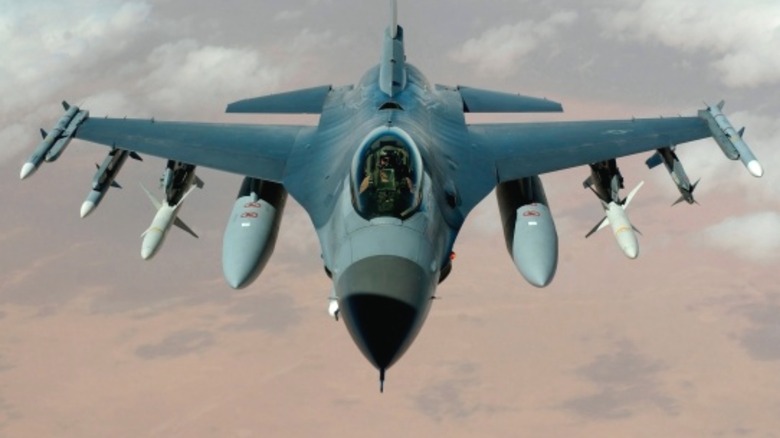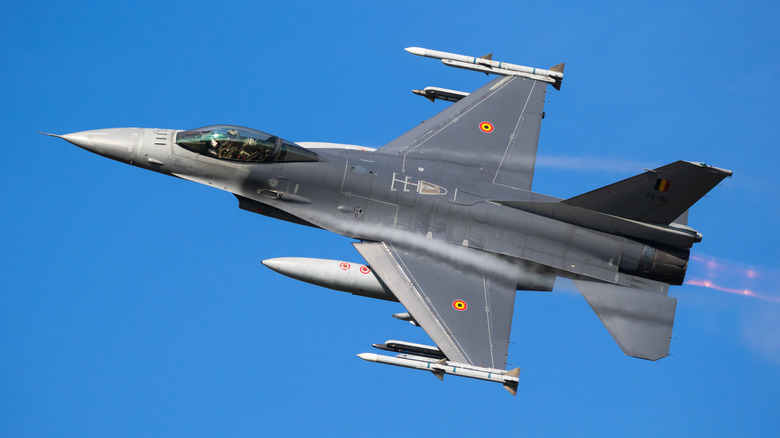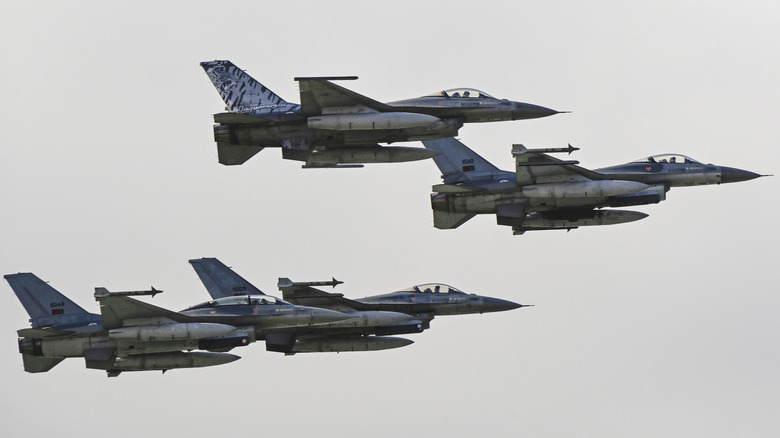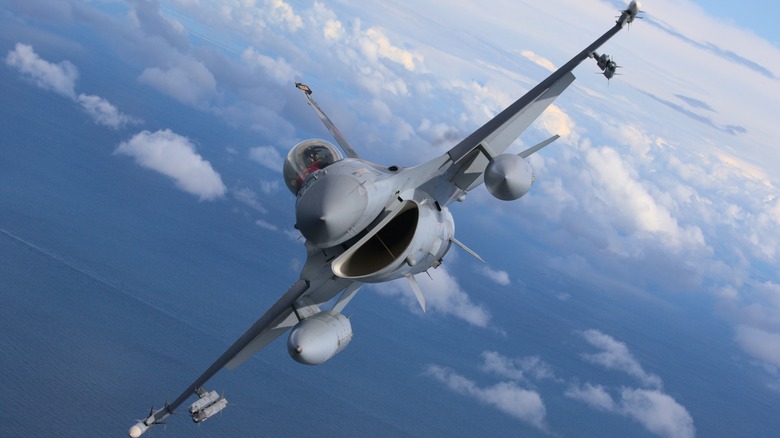Are F-16 Fighter Jets Still Used Today, And How Much Do They Cost To Make?
General Dynamics introduced the F-16 Fighting Falcon in 1979, and it's been an essential aircraft since. The F-16 is a multirole fighter that's dominated the skies for nearly half a century, and since its introduction, more than 4,600 have been built. However, it's been surpassed by the likes of the United States' fifth-generation fighters like the F-22 and F-35, and the U.S. military no longer purchases them.
Despite this, the F-16 remains a widely popular multi-role fighter deployed by American allies. Sales of the F-16 continue, and the reason for this is simple: F-16s are relatively inexpensive to build and maintain, they carry a large accompaniment of armaments and defensive capabilities, and their versatility makes them easily employable by air forces around the world — simply put, the F-16 is an excellent aircraft.
Still, it defies logic that a near-50-year-old aircraft could stand up to modern rivals like the Russian MiG-29, but that's precisely what it does. Ukraine desperately wants F-16s for its fight against Russia, and that's due to the aircraft's ability to gain and hold air superiority, which has been demonstrated over the course of its lifetime in numerous worldwide conflicts. Given its popularity, many may wonder what makes it so appealing. At the end of the day, what does an F-16 cost to purchase and maintain?
The F-16s strengths and weaknesses
No piece of military hardware is perfect, and there are always trade-offs in balancing an aircraft's offensive and defensive capabilities. The F-16 is no exception to this rule, and while it has many strengths, the F-16 isn't without a weakness or two. So many F-16s have been built, it's the most common fixed-wing combat aircraft, and for good reason. The aircraft's primary purpose is dogfighting, and it's good at what it does.
Pilots flying F-16s in combat can safely experience 9Gs in a dogfight, giving them an edge over other fighter pilots. Additionally, it innovated a "fly-by-wire" electric over manual flight control system that is now standard worldwide. This makes the aircraft easier to fly than older models. Plus, when it comes to armaments, the F-16 is no slouch. The base-model aircraft has an internal M61A1 20 mm Vulcan cannon and 11 hardpoints. These can hold a variety of missiles, rockets, bombs, and more.
In terms of weaknesses, the F-16 is technologically inferior to fifth-generation fighters, but that doesn't mean it's not lethal. F-16 upgrades and refits have kept pace with modern equivalents, so the current model F-16V brings the 45-year-old aircraft up to modern standards. One weakness not overcome by upgrades is the F-16's combat radius, which is, at most, 400 miles compared to the F-35's combat radius of 518 to 690 miles.
What does an F-16 cost?
Ultimately, an aircraft's use in combat is dependent on its cost since procuring and maintaining them is a first step in using an F-16. According to Simple Flying, an F-16 has a wide range in terms of cost, dependent upon which version of the aircraft a nation wants to purchase. The range is between $25 and $30 million, but that number climbs to as much as $60 to $70 million for the F-16V with modern enhancements added to the package.
The aircraft's first variants, the F-16C and F-16D, sold for under $20 million in the 1980s, which amounts to around $75.8 million in 2024 dollars. Executive Flyers reports some models sell for as little as $12.7 million, so the range is rather wide. While any of these amounts is a lot of money, it's relatively inexpensive compared to other fighters. The F-35, for example, costs between $81 and $156 million, according to Fortune.
Of course, procurement is only one aspect of the F-16's operation, as it requires continued maintenance to keep flying. This is where the aircraft's expense comes into play because it costs nearly $27,000 per flight hour. Each hour the aircraft flies requires 16 hours of maintenance, so using an F-16 for non-combat and combat operations is expensive. This is one of the challenges Ukraine faces in acquiring the aircraft despite its desperate need to claim air superiority over its own territory.
Why the F-16 keeps flying
The F-16 is a legacy aircraft, so it's not uncommon to wonder why it continues flying around the world. There are numerous reasons it remains active despite its age, but the main reasons are availability and cost. With more than 2,000 airframes currently operational worldwide, they remain accessible to a variety of nations. Cost is relatively low compared to modern equivalents, and with upgrades, the F-16 stays relevant.
For nations like Ukraine, hoping to retain territory, operating F-16s is easily within the wheelhouse of Ukrainian pilots, as they're comparatively easy to learn to operate. In addition to availability and cost, the F-16 has a proven track record in combat operations and as a multirole fighter capable of carrying out everything from dogfighting other fighters to bombing targets and intelligence, surveillance, and reconnaissance (ISR) missions over enemy territory.
Ultimately, the F-16 is an excellent fighter that's kept pace with modern equivalents, but there's more to it than that. In May 2024, the U.S. outfitted F-16s with automated AI-controlled systems, making the multirole fighter a highly efficient AI drone. While it may take years for these to become combat-effective, the inclusion of AI demonstrates the aircraft's versatility and ability to adapt to nascent technologies, ensuring the F-16 remains an active and popular platform for years to come.



